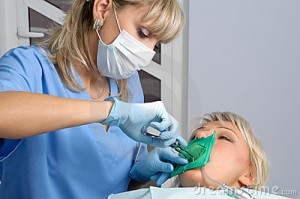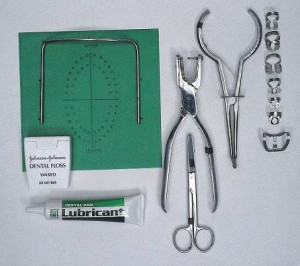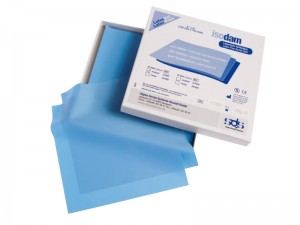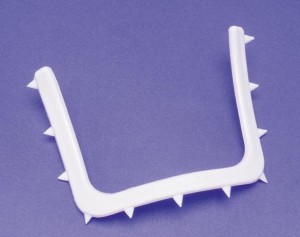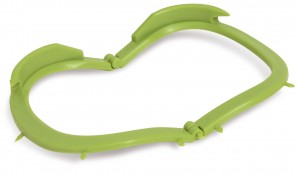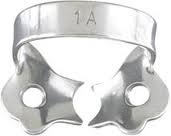Rubber dam, which is usually made up of latex rubber, is one of the most effective means of isolating teeth. Isolating teeth means preventing any saliva or debris from reaching the teeth during any dental procedures. It was developed by Barnum in 1864.Â
Purpose of using a rubber dam :
- Maintains a clean and visible field for the dentist
- Protects the patients – prevents aspiration of foreign bodies or accidental swallowing of foreign bodies
- Protects the dentist
- Reduces the risk of cross-contamination especially to the root canal system
- Retracts and protects the soft tissues of the mouth
- Increase efficacy by minimizing patient conversation and need for frequent rinsing
- Applications of medicaments without the fear of dilution
- Improved properties of restorative materials. If the restorative materials come in contact with the saliva, the properties of the material deteriorates.
- Psychological benefit to the patient
Contraindications/ It is not used in :
- A patient with upper respiratory tract infection, congestion of nasal passage or other nasal obstruction
- Presence of some fixed orthodontic appliances
- A recently erupted tooth that does not retain a clamp
- Patients allergy to latex
Precautions :
- Rubber dam should not obstruct the patient’s airway and thus should not cover his nose.
- Holes should be prepared in rubber dam for patients with upper respiratory tract obstruction.
- On patients with allergy to latex, latex free rubber dam should be used. Rubber dam napkin can be used to prevent the latex rubber dam from contacting the tissue
Armamentarium :
a) Rubber dam sheet
Rubber dam is available in various thickness as thin, flat latex sheets
- Thin : 0.15 mm
- Medium : 0.20 mm
- Heavy : 0.25 mm
- Extra heavy : 0.30 mm
- Special heavy : 0.35 mm
It is available in prefabricated size that is 5″ x 5″ or  6″ x 6″ while non-latex rubber dam is available in 6″x 6″ size.
The dam is manufactured in various colours. Darker colour offers better visual contrast but the lighter colour provides the advantage of illuminating the operating field and allows easier placement of film below the rubber dam.
b)Â Rubber Dam Frame
There are 2 types of rubber dam frame :
- Plastic Frame -Star Visiframe, Nygard-Ostby, Quick Dam
- Metal Frame – Young Frame
Starlite Visiframe
It is a U-shaped frame made of plastic. Because of its shape it exerts less tension on the dam and it is easier to use.
Nygaard-Ostby Frame
It requires no absorbent napkin and stands away from face. The most commonly used frame among the dentists.
Le Cadre Articule rubber dam frame
 It is a recent advancement in the types of frames developed to facilitate endodontic radiography. It is curved to fir the face and is hinged in the middle to fold back, allowing easier access for radiographic film placement.
Handidam
It provides adequate protection, are easy to apply and do not interfere with making radiograph.
c) Rubber Dam Punch
It aids in punching holes corresponding to the teeth size on rubber dam sheet
d) LubricantsÂ
Water soluable lubricants are applied in the area of punched holes for easier placement of the dam. eg: shaving cream or soap slurry.
e) Clamps Â
 These are made of shiny or dull stainless stell and consist of bow and 2 jaws. They aid in anchoring the dam to the tooth and in soft tissue retraction.
Types of clamps : Winged, Wingless, Serrated, Clamps with jaws cervically to engage erupting tooth or severely broken down teeth, Clamps with endo-illuminator system to illuminate pulp chamber and canal orifices.
Procedure For Rubber Dam Placement
- Select and prepare the rubber dam
- Decide the tooth to be clamped
- Select a clamp
- Introduce the materials to the child
- Tie a length of floss to the clamp
- Place the clamp, rubber dam and frame
- Slip a napkin near the rubber dam and spread it over the face
- Place protective coating of cocoa butter/petrolatum/varnish over silicate or GIC restorations to prevent dehydration.
- Adapt and slip a saliva ejector tip between the rubber and napkin on the non-operating side
Recent Advances in Rubber Dam Isolation
1. Hat Dam : It is a clear plastic form shaped like a hat without a top, this is trimmed and fitted around clinical crown that cannot be clamped, to hold the rubber dam in place.
2.Cushioning metal clamp jaw : Ferrite-N is a material that can be pressed in embrasure area. The material is light-cured, over which the clamp is seated.
3.Cushees : Soft thermoplastic cashew-shaped nodules, which are grooved on their inner surface, are slipped over tooth attachment blade of clamp prior to clamp application.
4. Fiber Optic Clamps : In the endo illuminator system, the high intensity light trans illuminates pulp chamber aand canal orifices. Fiber optic plastic clamps are used with this system
5. Liquid Dam : It is a resinous material used by the dentist.
